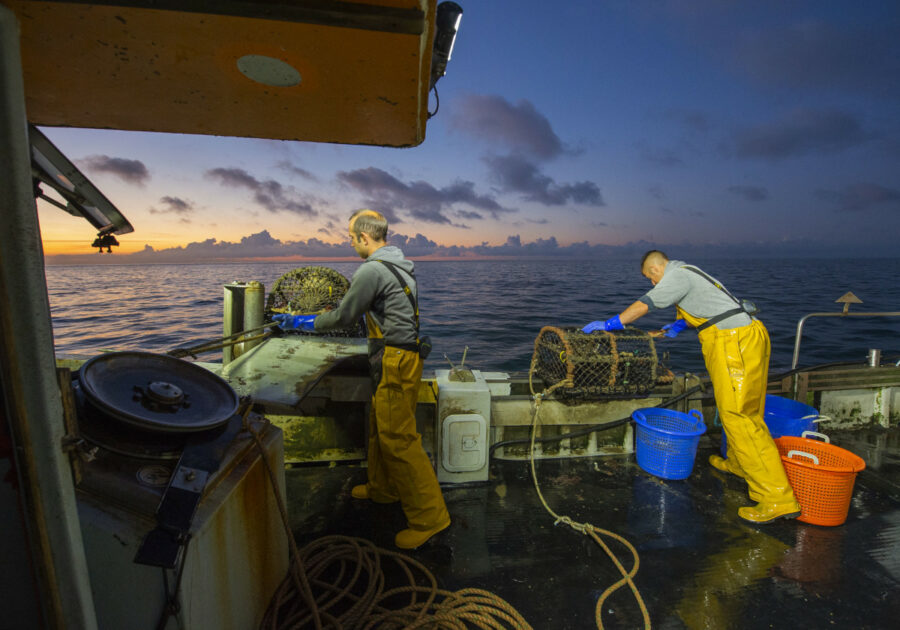A day’s potting from Selsey on Predator LI 556 underlined the importance of family and tradition in this south coast fishing community, reports John Periam. Photographs by Geoffrey Lee
The limestone rocks around Selsey create an ideal habitat for lobsters and crabs and rich feeding grounds for fish, and have provided an income for local fishing families going back many generations. Inshore fishing from this West Sussex town can be traced back as far as 3,200 years, and remains at the heart of the local community.
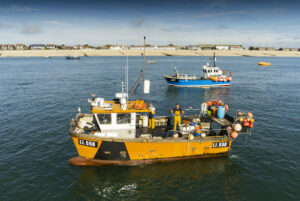
01. Predator returning to her mooring off Selsey.
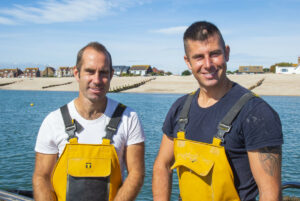
02. Brothers Chris Harvey (left) and Mike Harvey.

03. Hauling the second string as dawn breaks on a fine morning.

04. Predator is an 8.87m Gemini GF 9 glass-fibre catamaran.
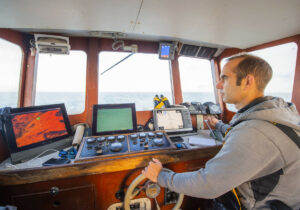
05. Chris steering Predator to the next string of pots.
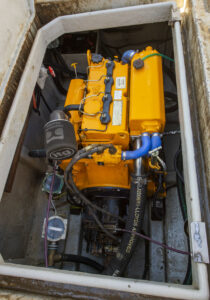
06. One of the two JCB Mermaid J-444 63kW diesel engines.

07. The 1.5t Hydroslave pot hauler and 48in gunwale roller are connected by a drop-in receiving table.
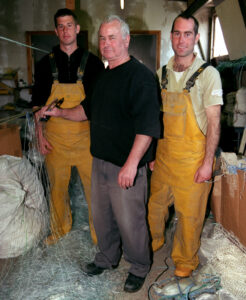
08. Mike (left) and Chris Harvey with their father Chris in his net-making loft in 2010. (Photo: John Periam)
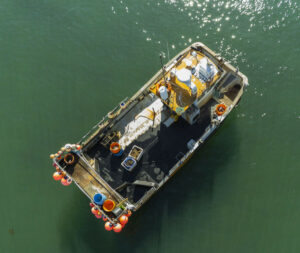
09. A bird’s-eye view of the deck layout on Predator.;
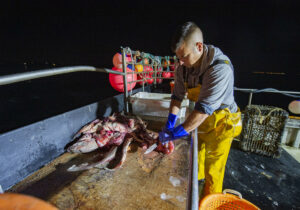
10. Mike cutting bait while steaming off from Selsey.
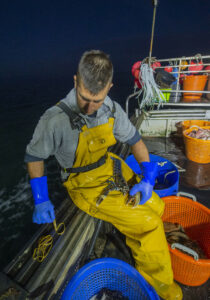
11. Banding lobsters from the first string of pots.
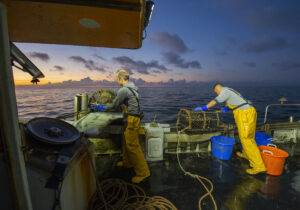
12. Positioning the next pot on deck as self-shooting continues.
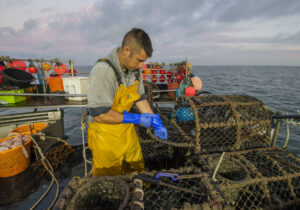
13. Mike making a small repair to a parlour pot…
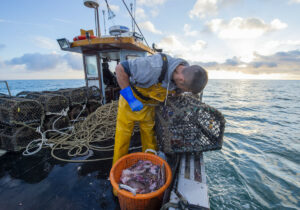
14. … and rebaiting a pot.
An invitation to go to sea with brothers Chris and Mike Harvey was an opportunity not to be missed. Their 9m catamaran Predator LI 556 is a proven workhorse, built by their father – another Chris – in 2004.
Both qualified skippers, the Harvey brothers are a longstanding team who have learnt to anticipate each other’s thoughts and moves. Chris Harvey said: “Teaming up with my brother has been very successful – we have a shared goal to do as well as we can. We can rely on each other, and know what we each need to do to make our day’s fishing as safe as possible. Of course we have our moments, but we get on very well indeed.”
The forecast for this early September trip was a WNW wind averaging 3-5mph, with the wind backing to WSW by midday. Geoffrey Lee had met the brothers in April 2016 when he was on the Sussex IFCA patrol vessel Watchful and the crew carried out a routine boarding of their vessel – so it was good to get reacquainted.
As the Selsey fishing fleet is moored at sea, it was first a case of boarding the brothers’ 4.5m glass-fibre tender, which was made from the cast of a wooden rowing boat. Mike Harvey fitted the 9.8hp two-stroke Tohatsu portable outboard engine onto the tender, before bait and some repaired and replacement parlour pots were lifted aboard.
Chris and Mike pushed the tender down the pebble beach to the shoreline, where they boarded for the short trip out to Predator, behind Dave Robinson, who was the first Selsey fisherman out that morning.
Predator slipped its mooring at about 4am and headed seven miles southeast towards Hooe Bank, where the day’s strings of pots were located.
Running off gave Chris and Mike the opportunity to familiarise Geoffrey Lee with Predator, a Gemini GF 9 glass-fibre catamaran, and give a comprehensive safety briefing. With dimensions of 8.87m LOA and beam 4m and a GT of 6.09t, Predator is powered by two JCB Mermaid J-444 63kW engines, and is fitted with Twin Disc Technodrive TM 170A gearboxes of 1.5:1 reduction, 2in-diameter shafts and 19in three-bladed bronze propellers that give a cruising speed of 7-8 knots. Bulbous bows were added to the hull in 2008 to improve bow lift and fuel efficiency.
Chris said: “We made sure the deck layout worked well for us, and designed it so there is plenty of room for hauling, stacking and shooting the pots whilst giving us space for storage of baskets and boxes of catch.”
In 2019, the previous davit arm arrangement was replaced with a 48in gunwale roller for pot self-hauling, at the same time as a new 1.5t Hydroslave pot hauler from KK Hydraulics was fitted. The Hydroslave hauler is driven off the starboard engine via a clutched hydraulic pump operated by a control lever positioned alongside the engine throttles mounted on the starboard gunwale. A drop-in plywood receiving table is positioned inboard of the rail roller, enabling pots to be smoothly pulled onboard. Chris and Mike said that the new hauling arrangements have made what can be heavy work much easier, and had been money well spent.
Wheelhouse electronics equipment on Predator includes a Sodena SoloWin 3D plotter, Raymarine DS600X sounder, Garmin GPSMAP 4012 chart plotter/radar/AIS, Simrad autopilot and Icom IC-M601 DSC VHF.
Each string of pots is made up of an AO or A1 buoy, 10 fathoms of 10mm Shamrock Polysteel rope, a double trawl float, which is used depending on the depth of the seabed, a further five fathoms of 8mm Polysteel rope, 15 fathoms of 12mm unleaded rope, 12 fathoms of 14mm unleaded rope, and the chain end weights. Each pot is spaced 12 fathoms apart, and there are normally 28 to 30 pots on each string. The leg rope is one fathom long, with 16mm Polysteel rope attached via a spinner.
The Harvey brothers use parlour pots from Mustang Engineering and East Coast Creels Ltd. All are 30in by 22in by 15in, constructed in 12mm steel, covered in 5mm braided netting and fully roped and rubbered, with a single 8in- or 10in-diameter bucket eye, end clearing door and bait bag. They work 500 pots, of which 280 to 300 are fished on a daily basis.
On approaching the chosen end of the first string, Chris slowly manoeuvred Predator so that Mike could use the boat hook to bring the first dahn of the day aboard. With the boat in neutral, Mike took the rope onto the hauler and slowly brought in the double trawl floats followed by the end weight, before the first parlour pot came over the gunwale roller.
At this stage, the brothers changed roles and Chris took control of the engines and hauling via the outside levers. Chris started hauling in the pots and slid them along to the next workstation, where Mike removed the catch, checked its size and state, put in fresh bait, and then stacked the pots on the port side of the deck ready for self-shooting. Occasionally, when a pot came fast on the seabed, the brothers would manoeuvre Predator to work the snagged pot free.
Once all the pots were onboard, Chris took Predator to the chosen point from which the first string was to be shot back, marking the dahn location on the Garmin GPSMAP 4012 plotter.
Each string took about 35 minutes to work from start to finish, and eight strings were hauled over the course of the day. Between strings, Mike cut up the next basket of bait – they use skate backs, smooth hounds and occasionally gurnard if they have any – measured lobsters and crabs to ensure they met the minimum landing size, banded the lobster claws and nicked the brown crab. There was also the routine maintenance of cleaning mud off the buoys and repairing pots where the netting had been damaged.
Both brothers were continuously checking to make sure that ropes did not get tangled as they hauled, stacked and shot the pots. They wore Spinlock Alto backpack PFDs, which are comfortable for working and do not impede movement.
Only a few other fishing boats from Selsey were sighted over the course of the day, including Nicholas C LI 90, owned and skippered by Chris’ brother-in-law John Reeves.
The brothers came ashore with 50kg of brown crab and 15kg of lobster. On their return to the mooring, the baskets of catch were lifted onto the tender. Once ashore, Chris and Mike used one of two Lister Petter single-cylinder LT1 diesel engines to winch the tender over plastic rollers to the top of the beach.
The catch was then transferred to a truck and taken to their hut next to the newly built RNLI Selsey lifeboat station. There it was divided into that to be sold at Potters, their family business, and that destined for Viviers (UK) Ltd.
The latter was driven a few hundred yards to Viviers’ weighing and storage facility at Selsey, where the brothers were met by general manager Mark Horstead. It was weighed and recorded before onward transport to Viviers’ headquarters at Camber Dock, Portsmouth, for sale on the wet fish counter.
Harvey family fishing
Fishing is in the Harvey brothers’ blood. Their father Chris went to sea in the early 1960s, but later sold his boat when he decided to open a net-making business in the town. As youngsters, Chris and Mike had the opportunity to go to sea with other fishermen, and built their experience up that way. Chris said: “Dad concentrated on running his business, which went from strength to strength. He was known as a quality net- and rope-maker, eventually selling products all over the UK.”
With his support, the brothers bought the first of several small boats. Then, 16 years ago, their father decided to build a catamaran with the help of local boatbuilder Andy Burgess, based at Sidlesham, to give Chris and Mike a proper start in their fishing career.
An average day for the brothers can begin any time after 3am, with a day’s fishing lasting up to eight hours. When the weather is good, Selsey makes an excellent base, as the moorings, fishing grounds, storage and distribution are all nearby. However, when the weather is too rough to launch the tender, they have to moor at Chichester, which adds five hours’ travelling to their day.
“Things have changed now,” said Chris. “When we started there were about 20 vessels fishing from Selsey – now there are about nine. It is a struggle at the moment – fishing for lobster is currently very slow, as it is along most of the south coast, and it is the same with the whitefish. The weather has been inclement to say the least, with some strong winds and bad storms. As a result, we have often not been able to go to sea for several weeks at a time. People forget that weather also acts as a quota.”
But survival can be down to determination, and neither Chris nor Mike intends to make a career change. They look towards a more positive future, and as a family are prepared to seek fresh challenges.
Mike said: “One of the biggest outlays is the boat itself, never mind its upkeep, the licence and the cost of replacing gear. In the spring we lost 50 pots – both of us feel we know where they went. At times, there are more foreign vessels in the area than there used to be. Is this because we are leaving the EU? I am not sure, but we are finding now that we have to be on the lookout more to protect our gear when it is at sea.”
Chris is now 38 and Mike 35, and both say that they would love to see more youngsters coming into the industry. They agree that they were lucky in having family support. Gone are the days when if one of them wanted a day off – say to visit the dentist – they could get a replacement crew member from Selsey. That just does not happen now. There are probably about a third of the fishermen there compared to when they started.
“It is the same all around the coast,” said Chris. “Selsey is one of those fishing communities that has one main road in and one out – so if you don’t live in the town, you have a drive in. Selsey does not have a harbour – all our vessels are anchored at sea, with tender support. If the weather turns foul, all we can do is head to Chichester Marina, where we can berth until we are able to get back to Selsey.
“Plans have been mooted several times for a small harbour at Selsey, but sadly, due to the current economic climate, this has had to be put on hold – maybe one day. Chichester Marina are very fair when it comes to us mooring boats there, and they look after us well – it is just the inconvenience of the extra travel involved.”
The brothers have invested in large tanks from the Fife-based firm Todd Fish Tech Company, which they have installed in their shed to hold live crab and lobsters. Chris said: “We installed the Lobster Pod in December 2016, and this was followed by a specially made crab tank in September 2019. The owners of Todd Fish Tech, Keith and Errin, were very supportive indeed. We can already see signs that this heavy investment is starting to pay off.”
The Lobster Pod storage system has 30 trays that can hold up to 300kg of lobster in seawater held at a constant temperature. Chris and Mike normally store between 10 and 15 lobsters per tray. They also have a 125kg crab holding tank.
The innovative, patent-pending Lobster Pod and the recently launched Crab Pod have a unique filter with a moving bed biofilter, protein skimmer, mechanical filter, ultraviolet steriliser and energy-efficient recirculation pump and seawater chiller. This keeps the seawater clean, clear and chilled, keeping the shellfish happy and healthy.
The stored lobsters and crabs are sold via a beachside café called Potters, which is run by their sister Katherine, their mother Trisha and Chris’ wife Sammie. Trisha and Katherine learnt about the fishing industry by working with Chris Snr in his net-making business. Following its closure, the family decided to look to fresh challenges.
Katherine said: “As one door closed, another opened, and Potters was launched. Once the new lifeboat station became operational, we were able to open up our stall on the Kingsway. Visitors love it, as well as many locals. Fresh shellfish is cooked each day by my father, which then goes on sale at the stall. We could do a lot more in supplying local hotels and restaurants, and this is something we eventually hope to expand on. What is also so nice is that it gives us the opportunity to meet the public and tell them about fishing in Selsey, with the odd menu discussed.
“To be able to say that the catching, cooking and preparation is all done by our family makes us feel incredibly proud. As for the boys, their father has watched them grow up with a determination to succeed. It is what fishing is all about – he respects and admires them immensely.”
Mike said: “We also supply a lot of our catch to Portsmouth fish wholesaler Viviers (Fishing News, 27 August, ‘Scallops in the Solent’). Eric McLeod has been very supportive of us over the past 15 years, and we are able to deliver our daily catch to Viviers’ small outlet in Selsey, which is run by ex-fisherman Mark Horstead. It saves us a long drive, and is then taken to Portsmouth and later that day to Billingsgate in London. This means that – except when weather means we have to go to Chichester Marina – our business is centralised at Selsey, which really helps.
“In Selsey the fishermen work well with each other, but go their separate ways. In the event of any incident at sea, they all pull together to support each other. There is a Selsey Fishermen’s Association, but sadly due to the coronavirus we have not met as normal. It is a very stressful time for everyone, and extra pressures do come to the fore at times.”
Both brothers supported coming out of the EU, and still do. Chris said: “We have committed ourselves to fishing, and enjoy it. Will things change? We will have to wait and see. It will take a lot of work to get it right. If we have the support of the MMO, NFFO and IFCAs along with the government and its fisheries minister, and they can all work together to protect our interests, it will be a real help. As individual fishermen we cannot do it on our own.”
Selsey Town Council has been very supportive, recently running the ‘Sea’s The Day’ project, which included an exhibition in Chichester. It also published an excellent book, Bringing the Catch Home, written by Janet McMeekin with the support of Selsey fishermen, which highlighted the challenges of earning a living in this strong fishing community.
Tony Delahunty OBE, who used to fish from Selsey and is now president of the NFFO, said: “The traditional Selsey fishing families are still working in the fishery, but there is a real and vital need to encourage and support young people to join the industry. I have watched Chris and Mike work together over many years, and what they have achieved as brothers inspires me. The family do not let things deter them. I do admire the fact that they are investing for the future at a time when many others in industries across the board are not. They started at a young age, and both are still active some 20 years later!”
Chris said: “Things happen so fast these days, and we have to be ahead of the game – people like Tony who are there behind the scenes and know about the industry are so important for its survival. We abide by the rules and regulations – at times too many – but we need less paperwork, and some of those in government need to know more about the industry. At times, the powers that be can listen to the wrong people. They need to listen to fishermen more. If anyone knows about sustainability and fish stocks, we do.
“It has been a frustrating year and a slow one, but it is a way of life that we both enjoy and would not change. We enjoy every part of it. Selsey beach is our working base, and if not at sea, we are often there doing things, and like to talk to people.” Listening to the older generation talk about their experiences still motivates them both – the survival of the Selsey fishing fleet is what it is all about.
The next 12 months are going to be interesting, but the Harveys are ready to take them on.

